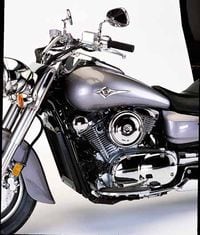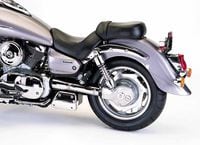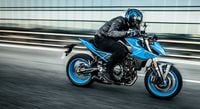At first, the 2003 Vulcan doesn't look all that far removed from the '02 bike. But after a couple of laps around its longer and lower streamlined perimeter, it's clear the VN1600 Classic inherits little from the VN1500 parts catalog. Basic engine architecture is the same, but 5mm more stroke bumps the fuel-injected liquid-cooled eight-valve V-twin's displacement from 1470cc to 1552cc. Cylinder sleeves are 5mm longer, also, but heads and pistons remain status quo. Higher-lift cams aim to fatten low-to-midrange torque.
A simplified exhaust system looses the bulky sub-muffler that rode behind the 1500's engine and gains a catalytic converter. Slash-cut mufflers clean up the look, allowing the new engine to exhale with socially acceptable authority. The crankshaft and balance shaft have been reconfigured to match, but shorter connecting rods keep the engine from getting any taller, letting designers move the whole bike closer to the street.
The new single-backbone steel frame is 100mm narrower than last year's skeleton, making room for a more graceful 5.3-gallon fuel tank. And because the stretched and slammed look is in, the 1600's fenders, seat and side cover are lower. Wheelbase is approximately 20mm longer than the 1500's; part of that extra length comes from a swingarm that's 30mm longer. Working with shocks mounted closer to vertical, the new swingarm is part of Kawasaki's plan to give the 1600 a smoother ride and more accurate handling. The rest comes from a 43mm fork in place of the previous 41mm unit, and tubeless tires mounted on new cast wheels. Dual front discs and a larger rear brake rotor should improve the 1600's performance envelope when it's time to slow down.
Looking a little closer reveals a list of detail improvements. Vulcan connoisseurs will note new square master cylinders for the clutch and front brake. Unlike some other Japanese factories who should know better, Kawasaki forms the Vulcan 1600 headlight and fork covers from chrome-plated steel, not plastic. Floorboards are reshaped, grips do without tacky faux-chrome plastic end caps, and engine oil lines are tastefully veiled behind the rocker-box cover. A thinner tank-mounted instrument panel--complete with new LCD fuel gauge--gives the cockpit a cleaner, more finished look.
Perhaps the best news is that at $10,499, admission price isn't much higher than the $10,599 you'd shell out for '02 Vulcan Classic 1500 Fi, which won't be back for '03. Nobody's making any promises as to when 1600s will actually materialize at your local Kawasaki dealer, but we'd bet heavily on being able to lay your dollars down before Daytona in March of next year.


/cloudfront-us-east-1.images.arcpublishing.com/octane/D2BDYKKNZ5GRHGDMI4PZTGRMME.jpg)

/cloudfront-us-east-1.images.arcpublishing.com/octane/UAY4WSZPOFDQRP4MCEXAKDFQOQ.jpg)

/cloudfront-us-east-1.images.arcpublishing.com/octane/X5CE3KSJHZHM5CUFGPZ7U26WB4.jpg)
/cloudfront-us-east-1.images.arcpublishing.com/octane/COWLTPGFAFGDDGJCTENYMA4VJM.jpg)
/cloudfront-us-east-1.images.arcpublishing.com/octane/H3PKUGPSUJFTND4RFPSI4OIDCE.jpg)
/cloudfront-us-east-1.images.arcpublishing.com/octane/UHGQA3MQDFCA3HLBWF7S76WH6Y.jpg)
/cloudfront-us-east-1.images.arcpublishing.com/octane/Q5EORCSTNFAVBJC4IYUHIKJTXQ.jpg)
/cloudfront-us-east-1.images.arcpublishing.com/octane/XIJ5FUFSP5A3NL7MOVZGJXAHC4.jpg)
/cloudfront-us-east-1.images.arcpublishing.com/octane/V5NZN3CGS5B5PPYFYJHIPAU5S4.jpg)
/cloudfront-us-east-1.images.arcpublishing.com/octane/CZE6ONOBU5E7HPIEEADU376C4M.jpg)
/cloudfront-us-east-1.images.arcpublishing.com/octane/UT4KL3SIYJBSPNHWJXTBE6MTGE.jpg)
/cloudfront-us-east-1.images.arcpublishing.com/octane/Q3UOIDZ22ZEVDBZUWGJXIMGJKI.jpg)
/cloudfront-us-east-1.images.arcpublishing.com/octane/YQM66WXZV5AAXNNOIUVOGVXZMY.jpg)
/cloudfront-us-east-1.images.arcpublishing.com/octane/J47NFTXNLFFGHELHZCUD2LCITA.jpg)
/cloudfront-us-east-1.images.arcpublishing.com/octane/NXPQBTLX3NCILKQ2GCFJYNIDEM.jpg)
/cloudfront-us-east-1.images.arcpublishing.com/octane/6U7NJLAYMRBZTIGNKWIA5OK2FQ.jpg)
/cloudfront-us-east-1.images.arcpublishing.com/octane/IYTZQWUROVC25IMTDEWUDQ5IQE.jpg)
/cloudfront-us-east-1.images.arcpublishing.com/octane/YJODDXEL2ZB5TENKPPN4BEYJAE.jpg)
/cloudfront-us-east-1.images.arcpublishing.com/octane/QEQQUZYNJFAIJB4DZFVFSNTCQ4.jpg)
/cloudfront-us-east-1.images.arcpublishing.com/octane/F4EEHDT3UZFKPLKVGDWMMPFEQE.jpg)
/cloudfront-us-east-1.images.arcpublishing.com/octane/J47U6OWNLBFBBG75A3ILAKFYZU.jpg)
/cloudfront-us-east-1.images.arcpublishing.com/octane/XWWQYTL3J5B7LKXDI354FFF4NQ.jpg)